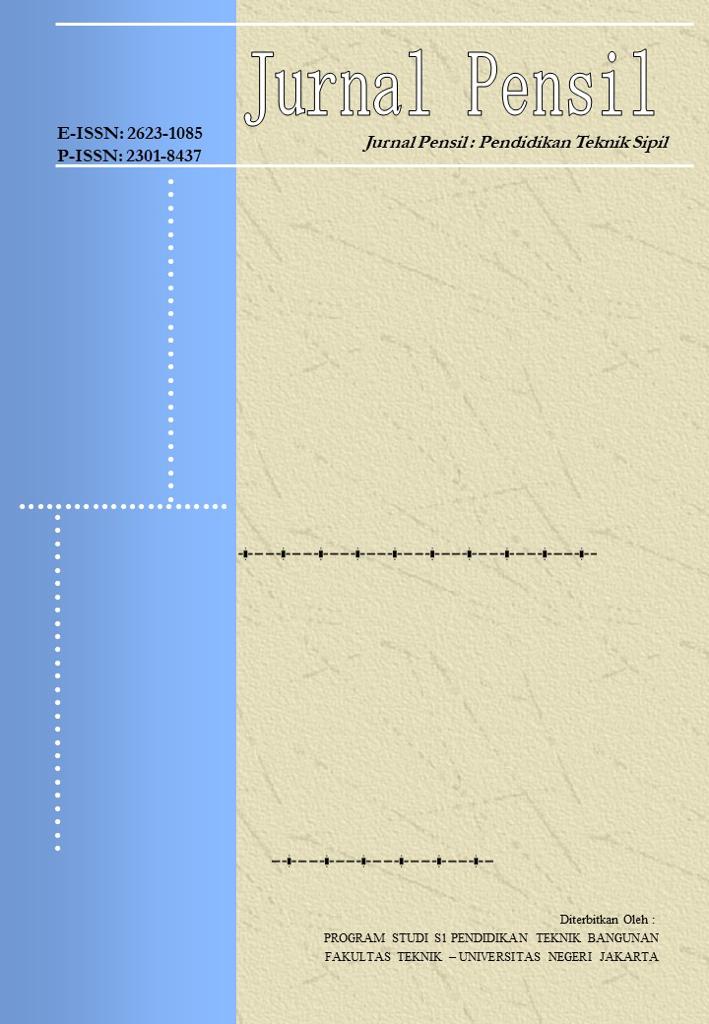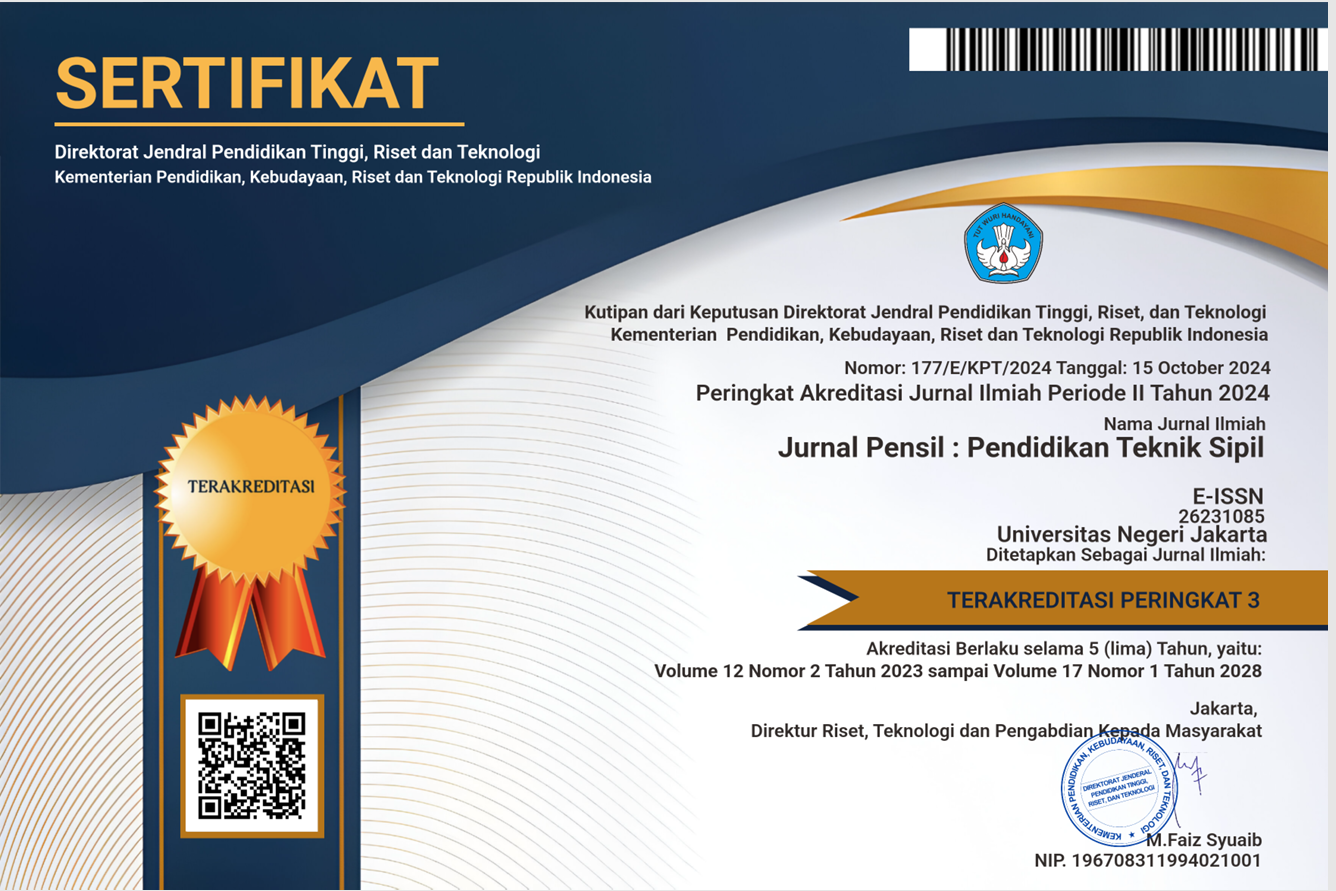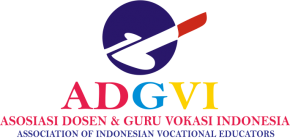FACTORS AFFECTING THE DEVELOPMENT OF AN INTEGRATED TOLL TRANSACTION SYSTEM TO IMPROVE TRAFFIC VOLUME DISTRIBUTION
DOI:
https://doi.org/10.21009/jpensil.v12i3.36337Keywords:
Congestion, Stated Preference, ETC, Congestion Pricing, Travel Time SavingsAbstract
The Indonesian government has attempted to reduce traffic congestion on toll roads by implementing a non-cash toll transaction system that has been valid on all Indonesian toll roads since October 2017. However, heavy traffic that causes traffic congestion on toll roads in urban areas often occurs. This study aimed to find out the factors that affect the development of the toll transaction system and the extent to which vehicles will be distributed through the preferences of road users to choose to enter the toll road or not. This research method used a quantitative descriptive approach with online and offline surveys through Stated Preference. Respondents were class I – V vehicle users who crossed Prof. Dr. Ir. Soedijatmo Toll Road with the direction of travel from the Jakarta Intra Urban Toll Road. The results of the study indicated that the implementation of contactless cashless toll transactions (Electronic Toll Collection (ETC)) can reduce the interest of road users to enter toll roads if fines are imposed, but on the other hand road users are still highly interested in entering toll road because there is a toll transaction time cut service. In the congestion pricing scenario, there was an increase in the distribution of traffic volume because the number of vehicles decreased along with the reduced interest of road users to enter the toll road due to the higher toll rate increase.
References
Adrian, F., & Pradoto, W. (2017). AEROTROPOLIS. Jurnal Pengembangan Kota, 7062(November). https://doi.org/10.14710/jpk.5.2.121-130
Alemazkoor, N., & Burris, M. (2014). Examining Potential Travel Time Savings Benefits Due to Toll Rates That Vary by Lane. Journal of Transportation Technologies, 04(03), 267–276. https://doi.org/10.4236/jtts.2014.43024
Brent, D. A., & Gross, A. (2018). Dynamic road pricing and the value of time and reliability. Journal of Regional Science, 58(2), 330–349. https://doi.org/10.1111/jors.12362
Bueno, P. C., Gomez, J., & Vassallo, J. M. (2017). Seeking Factors to Increase the Public’s Acceptability of Road-Pricing Schemes: Case Study of Spain. Transportation Research Record, 2606(1), 9–17. https://doi.org/10.3141/2606-02
Chiou, Y. C., & Fu, C. (2017). Responses of drivers and motorcyclists to congestion charge. Transportation Research Procedia, 25, 2957–2969. https://doi.org/10.1016/j.trpro.2017.05.197
Cornago, E., Dimitropoulos, A., & Oueslati, W. (2019). Evaluating the Impact of Urban Road Pricing on the Use of Green Transport Modes: The Case of Milan (Issue 143).
Croci, E. (2016). Urban Road Pricing: A Comparative Study on the Experiences of London, Stockholm and Milan. Transportation Research Procedia, 14, 253–262. https://doi.org/10.1016/j.trpro.2016.05.062
Dias, J., Matos, J. N., & Oliveira, A. S. R. (2014). The Charge Collector System. Procedia Technology, 17, 130–137. https://doi.org/10.1016/j.protcy.2014.10.220
Eliasson, J. (2019). Munich Personal RePEc Archive Congestion pricing (Issue 88224).
Green, C. P., Heywood, J. S., & Navarro, M. (2014). Economics Working Paper Series Traffic Accidents and the London Congestion Charge Traffic Accidents and the London Congestion Charge.
Hadji Hosseinlou, M., Zolfaghari, A., & Yazdanpanah, M. (2016). Road Pricing Effect on the Emission of Traffic Pollutants, a Case Study in Tehran. Civil Engineering Journal, 2(7), 306–315. https://doi.org/10.28991/cej-2016-00000035
Hamilton, C. J., Eliasson, J., Brundell‐Freij, Karin Raux, C., Souche, S., Kiiskilää, K., & Tervonen, J. (2014). Determinants of congestion pricing acceptability. In Centre for Transport Studies (Vol. 11).
Harnanda, A. Y., Priyanto, S., & Irawan, M. Z. (2022). DETERMINING FACTORS OF INTEREST IN THE USE OF TECHNOLOGY READNESS BASED MULTI LANE FREE FLOW (MLFF). International Journal of Economics, Business and Accounting Research, 2022(4), 2269–2289.
Haryono, S. (2019). Metode SEM untuk Penelitian Manajemen dengan AMOS, LISREL, PLS. Badan Penerbit PT. Intermedia Personalia Utama, 450.
Hermawan, R., Frazila, R. B., Awang, A., & Jihanny, J. (2013). Hubungan Antara Variasi Tarif Tol dengan Pendapatan dan Tingkat Pelayanan. Jurnal Teknik Sipil, 20(1), 55. https://doi.org/10.5614/jts.2013.20.1.7
Ho, H. C., Latifa, L., Clarice, C., & Raditya, A. (2019). On board unit for electronic toll collection service in supporting make Indonesia 4.0. Proceedings of the International Conference on Industrial Engineering and Operations Management, July, 68–78.
Indonesia. (2005). Peraturan Pemerintah Republik Indonesia PP No. 15 Tahun 2005 tentang Jalan Tol. In Deputi Sekretaris Kabinet Bidang Hukum dan Perundang-Undangan (pp. 1–23).
Japan International Cooperation Agency (JICA). (2019). Coordinating Ministry for Economic Affairs Republic of Indonesia JABODETABEK Urban Transportation Policy Integration Project Phase 2 in the Republic of Indonesia. In Jabodetabek Urban Transportation Master Plan Document (Issue October).
Javid, M. A., Al-Khatri, H. S., Al-Abri, S. S., Ali, N., Chaiyasarn, K., & Joyklad, P. (2022). Article Travelers’ Perceptions on Significance of Travel Time Saving Attributes in Travel Behavior: A Case Study in Oman. Infrastructures, 7(6), 1–16. https://doi.org/10.3390/infrastructures7060078
Kementerian PU. (2007). Keputusan Menteri Pekerjaan Umum Nomor 370/KPTS/M/2007 (p. 11).
Kementerian PU. (2014). Peraturan Menteri Pekerjaan Umum Nomor 16/PRT/M/2014 tentang Standar Pelayanan Minimal Jalan Tol (p. 10).
Kementerian PUPR. (2020). Peraturan Menteri Pekerjaan Umum dan Perumahan Rakyat Nomor 18 Tahun 2020 tentang Transaksi Tol Nontunai Nirsentuh di Jalan Tol.
Kementerian PUPR. (2021). Keputusan Menteri Pekerjaan Umum dan Perumahan Rakyat Nomor 265/KPTS/M/2021 tentang Penyesuaian Tarif Tol pada Jalan Tol Prof. Dr. Ir. Soedijatmo.
Linn, J., Wang, Z., & Xie, L. (2016). Who will be affected by a congestion pricing scheme in Beijing? In Transport Policy (Vol. 47, Issue August). https://doi.org/10.1016/j.tranpol.2015.12.006
Milenković, M., Glavić, D., & Kocić, A. (2019). ANALYSIS OF USERS’ ATTITUDES ON THE INTRODUCTION OF CONGESTION PRICING IN BELGRADE. Second International Conference “Transport for Today’s Society,” June. https://doi.org/10.20544/TTS2018.P19
Milenković, M., Glavić, D., & Mladenović, M. N. (2018). Decision-Support Framework for Selecting the Optimal Road Toll Collection System. Journal of Advanced Transportation, 2018. https://doi.org/10.1155/2018/4949565
Mirbaha, B., Saffarzadeh, M., Ehsan, S., Abrishami, S., & Pirdavani, A. (2014). Evaluating the Willingness to Pay for Urban Congestion Priced Zones (Case Study of Tehran). International Journal of Transportation Engineering, 1(3), 199–210.
Numrich, J., Ruja, S., & Voß, S. (2012). Global Navigation Satellite System based tolling: State-of-the-art. NETNOMICS: Economic Research and Electronic Networking, 13(2), 93–123. https://doi.org/10.1007/s11066-013-9073-9
Özgenel, M., & Günay, G. (2017). Congestion Pricing Implementation in Taksim Zone: A Stated Preference Study. Transportation Research Procedia, 27, 905–912. https://doi.org/10.1016/j.trpro.2017.12.065
Popoola, S. I., Popoola, O. A., Oluwaranti, A. I., Badejo, J. A., & Atayero, A. A. (2017). A framework for electronic toll collection in smart and connected communities. Lecture Notes in Engineering and Computer Science, 2(October), 723–726.
Purba, A., Susanto, D. A., & Werena, R. D. (2020). Assessing Factors Influencing Route Choice a Case Study of Terpeka Toll Road , Indonesia. 6th Int. Conf. on Structure, Engineering & Environment (SEE), Kyoto, Japan, 78–83.
Rizal, R. S., K, R. H., & S, T. L. (2019). Re-Evaluasi Penerapan Sistem Pengumpulan Tol Elektronis Di Indonesia. Jurnal Ilmiah Teknologi Infomasi Terapan, 5(2), 1–12. https://doi.org/10.33197/jitter.vol5.iss2.2019.275
Rizki, M., Karsaman, R. H., Santoso, I., & Frazila, R. B. (2016). Route divert behavior in jakarta electronic road pricing policy implementation. International Journal of Technology, 7(4), 571–580. https://doi.org/10.14716/ijtech.v7i4.2083
Selmoune, A., Cheng, Q., Wang, L., & Liu, Z. (2020). Influencing Factors in Congestion Pricing Acceptability: A Literature Review. Journal of Advanced Transportation, 2020(January). https://doi.org/10.1155/2020/4242964
Shatanawi, M., Abdelkhalek, F., & Mészáros, F. (2020). Urban congestion charging acceptability: An international comparative study. Sustainability (Switzerland), 12(12). https://doi.org/10.3390/su12125044
Singichetti, B., Conklin, J. L., Hassmiller Lich, K., Sabounchi, N. S., & Naumann, R. B. (2021). Congestion Pricing Policies and Safety Implications: a Scoping Review. Journal of Urban Health, 98(6), 754–771. https://doi.org/10.1007/s11524-021-00578-3
Sunitiyoso, Y., Nuraeni, S., Inayati, T., Hadiansyah, F., Nurdayat, I. F., & Pambudi, N. F. (2020). Road Pricing in Indonesia: How Will Public Respond? Transportation Research Procedia, 47(2019), 123–130. https://doi.org/10.1016/j.trpro.2020.03.084
Tan, J. Y., Ker, P. J., Mani, D., & Arumugam, P. (2017). GPS-based highway toll collection system: Novel design and operation. Cogent Engineering, 4(1), 1326199. https://doi.org/10.1080/23311916.2017.1326199
Velaga, N. R., & Pangbourne, K. (2014). Achieving genuinely dynamic road user charging: Issues with a GNSS-based approach. Journal of Transport Geography, 34, 243–253. https://doi.org/10.1016/j.jtrangeo.2013.09.013











.png)
.png)
1.png)

